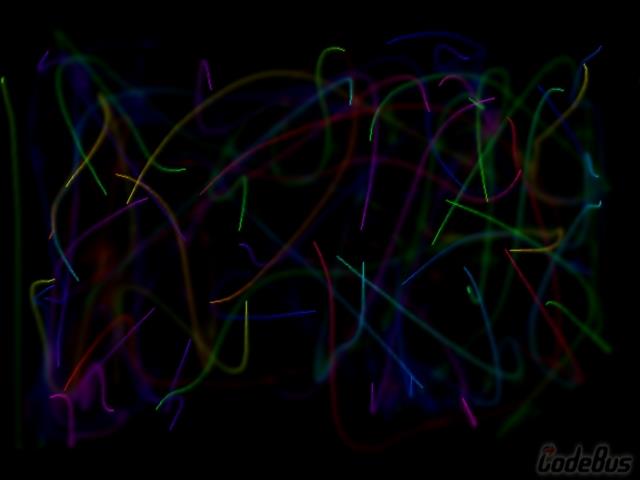自由运动的点(全屏模糊处理的范例)

2011-5-3 ~ 2021-4-3
(0)
这是个有趣的程序,同时是一个全屏模糊处理的范例。
其中,点的非直线自由运动的部分,是用的我在高中时候用 QuickBasic 实现的一种简单方法,看到这部分代码有点让人怀念过去。
简单说明一下:
为了使范例更清晰,全屏模糊处理的代码我做了简化,将第一行和最后一行忽略掉了。通过代码可以清晰地看到,所谓全屏模糊,其实就是对每个点与相邻的几个点的颜色做平均处理(可以自己决定每个点的权重)。
这个模糊函数只处理了每个点的上、下、左、右共 5 个点。为了获得不同的效果,可以试试将周围八个点一起处理,或者上、下、左、右方向上的两个点一起处理。
严格来说,每个点在运算时,所使用的左边和上边的点,其实已经不是原来的点了,而是模糊后的点。所以这样的模糊处理对于单个点来说,右边和下边颜色要淡一些。如果需要精确的模糊,可以借助 IMAGE 实现,这里就不再多说了。
延时没有用常用的 Sleep 实现,而是使用的精确延时,详见文章《精确延时的实现》
下面是运行动画的截图:

代码如下:
///////////////////////////////////////////////////
// 程序名称:自由运动的点
// 编译环境:Visual C++ 6.0 / 2010,EasyX_20200727
// 作 者:yangw80 <yw80@qq.com>
// 最后修改:2011-5-3
//
#include <graphics.h>
#include <conio.h>
#include <math.h>
#include <time.h>
#define AMOUNT 64
// 全屏模糊处理
// (为了简化范例,该函数略去了屏幕第一行和最后一行的处理)
void Blur(DWORD* pMem)
{
for(int i = 640; i < 640 * 479; i++)
{
pMem[i] = RGB(
(GetRValue(pMem[i]) + GetRValue(pMem[i - 640]) + GetRValue(pMem[i - 1]) + GetRValue(pMem[i + 1]) + GetRValue(pMem[i + 640])) / 5,
(GetGValue(pMem[i]) + GetGValue(pMem[i - 640]) + GetGValue(pMem[i - 1]) + GetGValue(pMem[i + 1]) + GetGValue(pMem[i + 640])) / 5,
(GetBValue(pMem[i]) + GetBValue(pMem[i - 640]) + GetBValue(pMem[i - 1]) + GetBValue(pMem[i + 1]) + GetBValue(pMem[i + 640])) / 5);
}
}
// 点的结构
struct SPOT
{
int x, y;
int targetx, targety;
int dx, dy;
COLORREF color;
};
// 精确延时函数(可以精确到 1ms,精度 ±1ms)
// (原理在 www.easyx.cn 有文章详细解释)
void HpSleep(int ms)
{
static clock_t oldclock = clock(); // 静态变量,记录上一次 tick
oldclock += ms * CLOCKS_PER_SEC / 1000; // 更新 tick
if (clock() > oldclock) // 如果已经超时,无需延时
oldclock = clock();
else
while(clock() < oldclock) // 延时
Sleep(1); // 释放 CPU 控制权,降低 CPU 占用率
}
// 主函数
int main()
{
// 初始化
initgraph(640, 480); // 创建绘图窗口
srand((unsigned)time(NULL)); // 设置随机种子
DWORD* pMem = GetImageBuffer(); // 获取显示缓冲区地址
// 定义所有点
SPOT spots[AMOUNT];
// 初始化每个点
for(int i = 0; i < AMOUNT; i++)
{
spots[i].x = spots[i].targetx = rand() % 600 + 20;
spots[i].y = spots[i].targety = rand() % 440 + 20;
spots[i].dx = rand() % 40 - 20;
spots[i].dy = (int)sqrt(400 - spots[i].dx * spots[i].dx) * ((rand() % 2) * 2 - 1);
spots[i].color = HSLtoRGB((float)(rand() % 360), 1.0, 0.5);
}
while(!_kbhit())
{
for(int i = 0; i < AMOUNT; i++)
{
setcolor(spots[i].color);
moveto(spots[i].x, spots[i].y);
spots[i].targetx += spots[i].dx;
spots[i].targety += spots[i].dy;
// 判断是否越界,以及越界处理
if (spots[i].targetx <= 0)
{
spots[i].dx = rand() % 20;
spots[i].dy = (int)sqrt(400 - spots[i].dx * spots[i].dx) * ((rand() % 2) * 2 - 1);
}
else if (spots[i].targetx >= 639)
{
spots[i].dx = - rand() % 20;
spots[i].dy = (int)sqrt(400 - spots[i].dx * spots[i].dx) * ((rand() % 2) * 2 - 1);
}
if (spots[i].targety <= 0)
{
spots[i].dx = rand() % 40 - 20;
spots[i].dy = (int)sqrt(400 - spots[i].dx * spots[i].dx);
}
else if (spots[i].targety >= 479)
{
spots[i].dx = rand() % 40 - 20;
spots[i].dy = - (int)sqrt(400 - spots[i].dx * spots[i].dx);
}
// 未越界时,有 10% 的概率改变运行方向
if (rand() % 10 < 1)
{
spots[i].dx = rand() % 40 - 20;
spots[i].dy = (int)sqrt(400 - spots[i].dx * spots[i].dx) * ((rand() % 2) * 2 - 1);
}
// 计算新点坐标,画线
spots[i].x += (int)((spots[i].targetx - spots[i].x) * 0.1);
spots[i].y += (int)((spots[i].targety - spots[i].y) * 0.1);
lineto(spots[i].x, spots[i].y);
}
// 全屏模糊处理
Blur(pMem);
// 延时
HpSleep(33);
}
// 按任意键退出
closegraph();
return 0;
}

添加评论
取消回复